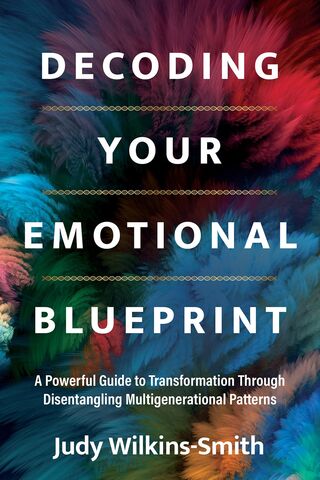Genetics
Decoding Your Emotional Blueprint
The Book Brigade talks to family therapist Judy Wilkins-Smith.
Posted June 14, 2022 Reviewed by Abigail Fagan

The emotional suffering we experience tends to close us up to insight about the problems we face. There may be more hope for solutions in looking at the broader context.
What is an emotional blueprint and does everyone have one?
An emotional blueprint is the compilation of patterns of thoughts, feelings, and actions that we inherit from our ancestors who create emotional DNA in response to events that happen to them. The way they respond to an event and then pass down those responses is what I call emotional DNA; it creates an emotional blueprint for the way subsequent generations will respond to events or stimuli—until someone says they want more or different and mindfully starts to tweak or turn the current patterns, creating new emotional DNA.
Yes everybody has one, even those of us who do not know their history. To find it, look at the inexplicable patterns in your own behavior. They are often tied to that blueprint.
How does one get their emotional blueprint and what does it do?
The blueprint is passed down via the unique systemic language and behaviors that live in the family system in response to events, and it pretty much runs our lives. Let me give you an example. A client tells me, "In our family marriages don't last. You can't depend on a man, they always disappear." As we explore her family history we find out that great-grandma lost her husband in a war. So, yes, she didn't have a man around, and she had to depend on herself, but that was because he died.
However, the unconscious loyalty to the suffering of the great-grandmother can then cycle down as, "You can't depend on a man, they disappear." This is deeply felt as a truth. Grandma's husband walks out and Mom's husband goes off to find himself. So now my client is terrified of getting into a relationship because she knows the outcome.
When she can see the pattern and give it its place in the system and understand what happened, she can make a different choice and consciously be the first woman to choose a husband who will stay. The systemic blueprint can now change.
See how it unconsciously yet powerfully runs the show? And we do this all the time.
Another way to explain it is this: An event happens and we immediately react to it. We have thoughts, feelings, and actions around it. Those create a language and library of thoughts, feelings, and actions, and if we feel those deeply and our body and mind agree with what we are telling ourselves, it becomes the truth. Only it's not the truth, it's your truth, and you can change that any time you want to.
You refer to “emotional DNA.” What does that mean?
Emotional DNA is that pattern of thoughts, feelings, actions, inactions, meanings assigned that you inherit, and it runs your life powerfully and yet unconsciously—until you look and then mindfully make other choices. Emotional DNA is found in every aspect of your life, regarding money, success, relationships, leadership, and it dictates how successful or limited you will be, depending on your choice to stay in line with what's there or to change or expand what's there.
How does thinking in terms of emotional DNA expand understanding of human nature when we know that emotional capacity and responsivity are built not from a blueprint but very much from experience, especially early experience?
Emotional DNA explains that not only do you respond to early experiences in your own life but also to the experiences of prior generations. Their experiences color yours even when you don't know them. Think about children separated from their mothers at birth who reunite later and find they have lived similar lives. The blueprint is always there.
Emotional DNA also works in the realm of human potential. It looks at what you have right now, how it's inhabiting your mindsets and behaviors, finds the gift in even the worst events—and there is always one waiting to be discovered—and shows how a current limiting or empowering pattern lives in you and what it's waiting to become. It also illustrates the potential for a new, stronger and more insightful strand of emotional DNA to evolve through you and enables you to see what you're capable of achieving and passing on.
Are there some common kinds of invisible patterns that people get from their families?
Absolutely. Many. Patterns run the show. Money patterns, relationship patterns, leadership patterns, success and failure patterns, fear patterns, capability and resilience patterns, PTSD and eating patterns, drinking patterns. health patterns, fertility patterns.
How do the emotional blueprints you refer to hamper people?
I love this question. It happens this way. See the example above? The lady who was struggling with relationships? Well that becomes an echo in the family system that then limits the women because they all respond to the idea that they too will lose a man; that becomes a self-fulfilling prophecy. Now rich and full relationships are not possible for them. The same goes for something like money; if we are told that all rich people are greedy and cheat, lie, and steal, then we wonder why we can't hold onto money.
In all cases we have a few ways to go. Either we repeat the pattern—and we do so, by the way, as a way to belong in our family system—or we change the pattern. It's also important to remember that a limiting pattern was once a solution; it has simply outlived its usefulness.
Is there some type of good emotional DNA that people get, and, if so, what does it look like or do?
Yes, indeed. Think of the values you cherish, that shape the bigness of who you are. You may think you developed them all by yourself, but look around you and you will see that Mom or Dad or perhaps a grandparent or teacher held flavors of the same ones. Perhaps you are told: "Everyone in our family is smart and we all do well." This becomes a reality and so we see generations of a successful family. Or “everyone in our family does well with money,” and so you are taught about money and become fluent in finances just like the others.
The joy of emotional DNA is that both are always there and always available if we know how to look, assimilate, and grow. This leads, of course, to constellations that enable you to literally see and explore your family system and your place in it.
When I work with clients, they bring their issue or their desires. The issues are often tied to a systemic inheritance trying to rest and the desires are tied to the chapter that only you can write once you know how. I always address both. When you don't, the client can be left hanging.
How does seeing problems as systemic help people solve their problems?
It tends to create context for what's happening to and around them, and it opens the doors to hope, insight, and possibility. By engaging the sights, sounds, and feel of the issue, you are engaging multiple senses, which facilitate deep insights. You can literally see the relationships between the different parties. Something you cannot do in your head.
Can you give an example of the difference in viewing a problem systemically and viewing it individually?
"It's all my fault" is individual, whereas "Where is this coming from, how is it affecting me, and what can I do with it?" is systemic. Connections create possibility thinking, which in turn lights up opportunities that can lead to purpose, which in turn pulls you all the way past the old excuses and resistance.
You talk about “constellations”—what are they and how does thinking about them help people?
Constellations are a 3D representation of a system with respect to the issue at hand. With clients I may use either live representatives or floor anchors ( pieces of paper with arrows on them). We select representatives of all the different parts of the system in question. For example, Mom, Dad, sister, brother, client. Then I ask the client to place them in relationship to one another, creating a spatial representation of the way things are for the client. It begins to illuminate the connections, disconnections, obstacles, and opportunities as well as possibilities.
The Aha! moments, transformations, and rewirings happen in part because of the clarity of the 3D image and the engagement of multiple senses, which in turn creates a multisensorial and embodied experience that activates new neural pathways. They also happen because recognizing a pattern that you have carried in your head often creates a visceral jolt. Systemic questions lead you out of the jolt to new insights and growth.
What is the single most important message you want people to get out of your book?
There's no such thing as a train wreck. They are simply portals to possibility, and when you see what lives in your system and what it's trying to become through you, everything changes. You are only struggling because you are inside a box that's too small for you and it's asking you to grow. You have a chapter that only you can write, and it's just waiting for you to see it. And most of all, you are a remarkable being if only you know how to see it. How big are you willing to be?
About THE AUTHOR SPEAKS: Selected authors, in their own words, reveal the story behind the story. Authors are featured thanks to promotional placement by their publishing houses.
To purchase this book, visit: Decoding Your Emotional Blueprint





